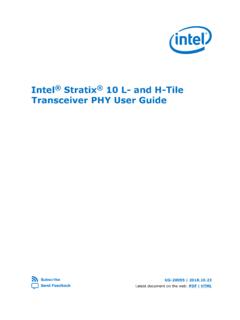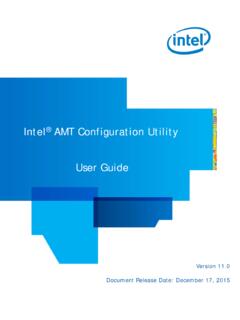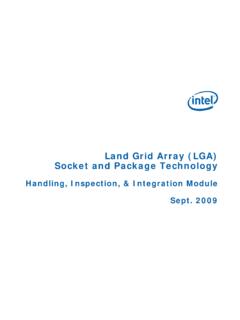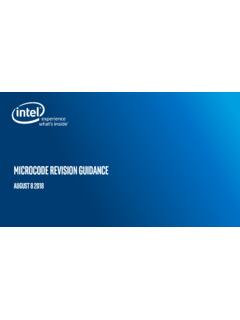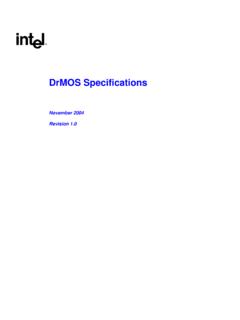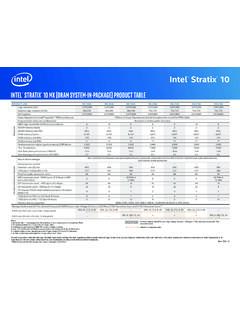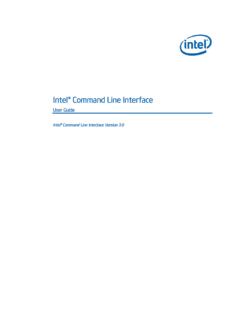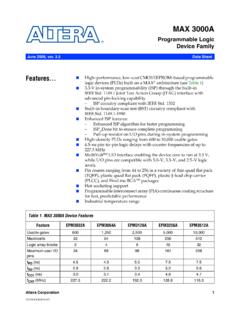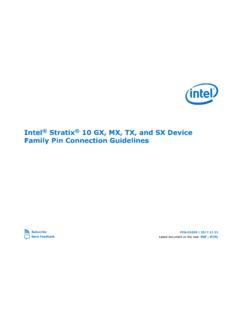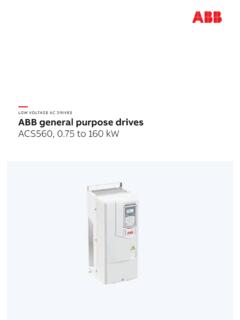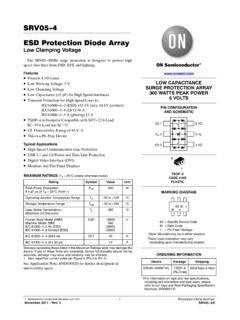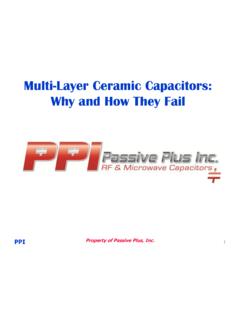Transcription of SMT Board Assembly Process Guide - Intel
1 SMT Board Assembly Process Recommendations Intel Manufacturing Enabling Guide March 2016. Intel Manufacturing Enabling Guide March 2016. SMT Board Assembly Process Disclaimers INFORMATION IN THIS DOCUMENT IS PROVIDED IN CONNECTION WITH Intel . PRODUCTS. NO LICENSE, EXPRESS OR IMPLIED, BY ESTOPPEL OR OTHERWISE, TO ANY INTELLECTUAL PROPERTY RIGHTS IS GRANTED BY THIS DOCUMENT. EXCEPT AS PROVIDED IN Intel 'S TERMS AND CONDITIONS OF SALE FOR SUCH. PRODUCTS, Intel ASSUMES NO LIABILITY WHATSOEVER AND Intel DISCLAIMS. ANY EXPRESS OR IMPLIED WARRANTY, RELATING TO SALE AND/OR USE OF Intel . PRODUCTS INCLUDING LIABILITY OR WARRANTIES RELATING TO FITNESS FOR A. PARTICULAR PURPOSE, MERCHANTABILITY, OR INFRINGEMENT OF ANY PATENT, COPYRIGHT OR OTHER INTELLECTUAL PROPERTY RIGHT. UNLESS OTHERWISE. AGREED IN WRITING BY Intel , THE Intel PRODUCTS ARE NOT DESIGNED NOR. INTENDED FOR ANY APPLICATION IN WHICH THE FAILURE OF THE Intel . PRODUCT COULD CREATE A SITUATION WHERE PERSONAL INJURY OR DEATH MAY.
2 OCCUR. Intel may make changes to specifications and product descriptions at any time, without notice. Designers must not rely on the absence or characteristics of any features or instructions marked "reserved" or "undefined." Intel reserves these for future definition and shall have no responsibility whatsoever for conflicts or incompatibilities arising from future changes to them. The information here is subject to change without notice. Do not finalize a design with this information. No license (express or implied, by estoppel or otherwise) to any intellectual property rights is granted by this document. Copies of documents which have an order number and are referenced in this document may be obtained by calling 1- 800-548-4725 or visit Any forecasts of goods and services needed for Intel 's operations are provided for discussion purposes only. Intel will have no liability to make any purchase in connection with forecasts published in this document.
3 Statements in this document that refer to Intel 's plans and expectations for the quarter, the year, and the future, are forward-looking statements that involve a number of risks and uncertainties. A detailed discussion of the factors that could affect Intel 's results and plans is included in Intel 's SEC filings, including the annual report on Form 10- K. Intel disclaims all express and implied warranties, including without limitation, the implied warranties of merchantability, fitness for a particular purpose, and non- infringement, as well as any warranty arising from course of performance, course of dealing, or usage in trade. All information provided here is subject to change without notice. Contact your Intel representative to obtain the latest Intel product specifications and roadmaps Intel technologies may require enabled hardware, specific software, or services activation. Check with your system manufacturer or retailer. Intel technologies'.
4 Features and benefits depend on system configuration and may require enabled hardware, software or service activation. Performance varies depending on system configuration. No computer system can be absolutely secure. Check with your system manufacturer or retailer or learn more at [ ]. No computer system can be absolutely secure. Intel , the Intel logo, Intel Core are trademarks of Intel Corporation in the and/or other countries. *Other names and brands may be claimed as the property of others. 2016 Intel Corporation Intel Manufacturing Enabling Guide 2. March 2016. SMT Board Assembly Process Table of Contents 5. Solder Paste Printing ..5. Component Reflow Soldering ..6. Pb-free Reflow Soldering .. 6. Reflow Profile Development Considerations .. 7. Sample Reflow Parameters .. 12. Sample Reflow Profiles .. 14. 16. Rework Profile Board Preparation .. 16. Pad Cleanup After Component Removal .. 18. Paste Printing Methods at Rework .. 18. Re-balling BGA's Not Recommended.
5 20. Sample Rework 21. Rework Profile Development .. 22. Sample Rework Profiles .. 24. Revision Summary .. 25. Figures Figure 2-1 Reflow Profiling TC Location Example (BGA or Socket) ..8. Figure 2-2 SMT Joint Temperature TC Placement Example ..8. Figure 2-3 Sample Reflow Parameters .. 14. Figure 2-4 Sample Desktop Reflow 14. Figure 2-5 Sample Mobile Reflow Profile .. 15. Figure 2-6 Sample Server Reflow Profile .. 15. Figure 2-7 Rework Profiling TC Location Example (BGA or Socket) .. 16. Figure 2-8 Sample Rework 22. Figure 2-9 Sample Rework Profile Development .. 23. Figure 2-10 Sample BGA Rework Profile .. 24. Figure 2-11 Sample Socket Rework Profile .. 24. Intel Manufacturing Enabling Guide 3. March 2016. SMT Board Assembly Process Tables Table 2-1 Sample Reflow Parameters .. 12. Table 2-2 Sample Rework Parameters .. 21. Intel Manufacturing Enabling Guide 4. March 2016. SMT Board Assembly Process Introduction This chapter addresses the surface mount technology (SMT) Board Assembly Process for reflow soldering SMT components to boards, as well as rework soldering for removing and replacing individual components on already-assembled boards.
6 The information in this document is for reference only. Manufacturing processes are unique, and may require unique solutions to ensure acceptable levels of quality, reliability, and manufacturing yield. Due to differences in equipment and materials, customer-specific Process parameter development and validation is required. Solder Paste Printing Although there are a number of lead free (Pb-free) alloys, the most commonly used compositions contain tin, silver, and copper, commonly expressed as SAC, for SnAgCu. Within SAC solders, by far the most common usage is Sn/3 , a near-eutectic which melts between 217 C and 220 C. Stencil aperture sizes can be 1:1 with pad size, but certain parts may require reduced or increased stencil apertures to reduce solder ball defects. For example, in the BGA world, the thinning of substrates and overall package thickness has led to increased package warpage during the SMT Process , and hence the need to adjust stencil openings.
7 In some cases the package may tend to bend away from the PCB during SMT reflow leading to an open, and by increasing paste volume deposited on the PCB pads via the stencil aperture size, you can compensate for this gap and ensure a good joint between package and PCB during reflow. The reverse situation can also occur, where a package warps and compresses against the PCB, and a smaller stencil aperture is required to minimize bridging defects. using a metal squeegee reduces scavenging and provides more consistent printed paste volume. Intel Manufacturing Enabling Guide 5. March 2016. SMT Board Assembly Process Process parameters (such as squeegee speed, pressure, and separation speed) need to be optimized for the specific solder paste used. Component Placement Pick and place machines are used to place components on boards. Front-side lighting is often used for ball recognition on BGA's. Reflow Soldering In reflow soldering, the solder paste must be heated sufficiently above its melting point and become completely molten, in order to melt the balls of BGA components, causing them to collapse and form reliable joints.
8 In the case of components with leads, the solder paste must wet the plating on component leads to form the desired heel and toe fillets. Solder joint formation depends on temperature and time which are reflected in the reflow profile. In BGA's the balls on the component are the main contributor to the solder volume of the joint and the paste volume applied is critical to the formation of the joint. There is no one best reflow profile for all Board assemblies. Ideally, a reflow profile must be characterized for each Board Assembly using thermocouples at multiple locations on and around the device. The solder paste type, component and Board thermal sensitivity must be considered in reflow profile development. Pb-free Reflow Soldering Pb-free reflow requires relatively high temperatures, due to the high melting range of typical Pb-free solders. Typical Pb-free solder such as SAC305 (Sn/3 ) have s an initial melting point of 217 C and a final melting point of 220 C.
9 Pb-free reflow soldering requires a narrow temperature range, in order to produce reliable joints, without damaging components. Intel Manufacturing Enabling Guide 6. March 2016. SMT Board Assembly Process Because of additional oxidation that occurs at higher temperatures, an inert reflow atmosphere (nitrogen) may be beneficial for Pb-free reflow soldering. Of course, high temperatures drive the need for all Pb-free components to be rated to higher temperatures. Finally, these high temperatures, along with thinner packages, can cause greater warpage in PCB's, and in some cases, may require alternate PCB materials, support pallets, careful attention to specific paste formulations, and carrier fixtures during reflow. Reflow Profile Development Considerations Each customer should develop their own reflow profile and oven settings, appropriate to their materials, equipment, and products. As a starting point, this chapter contains considerations and recommendations for reflow solder parameters.
10 Because some reflow parameters differ with solder paste formulation (even if they have the same metal composition), the profile envelope recommended by the solder paste manufacturer should be considered. Reflow Profile Board Preparation Reflow profile measurement is a vital part of setting up reflow the solder conditions. The measurements are typically carried out using thermocouples attached to a high temperature resistant recording device which travels through the reflow oven furnace with the PCB. under test. Special care must be taken to ensure proper placement of thermocouples to accurately measure temperature at the desired locations. Unless stated otherwise, all temperatures in this chapter are measured at solder joints, rather than at components bodies, PCB surface, or air around components. This provides the best repeatability and accuracy. Thermocouples (TC's) for solder joints should be placed in joints expected to be the hottest and coolest, so that the range of peak temperatures for all components on the Board can be confirmed to be within specifications.

